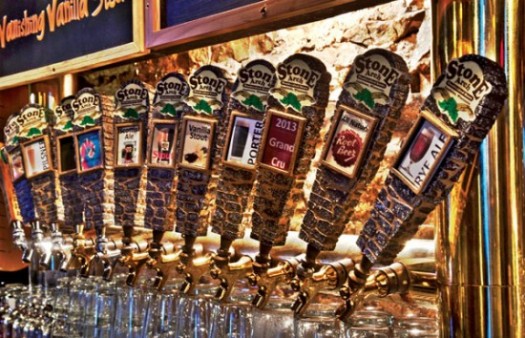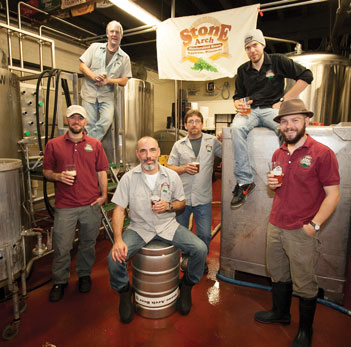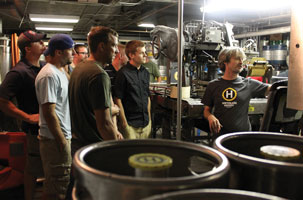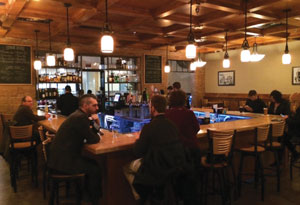Discovering your craft
Local breweries offer handcrafted, flavorful options
Another 9 to 5. You are looking to kick your feet up and perhaps, grab a favorite drink. Yes, the classic light American lager may be your go-to beverage, but chances are a local craft brewery is creating something brand new and bursting with flavor.
“It’s a big push for quality. People try it and they realize, wow, there is a lot of flavor,” says Steve Lonsway, owner and brewmaster of Appleton’s Stone Arch Brew House. People are relishing the new, dynamic tastes found in India Pale Ale, barrel-aged beers, sours and more.
The recent spike in consumer interest has brought on the resurgence of local breweries. The Fox Valley, in particular, was once a booming center for beer production.
“Back then, the brewery was pretty much self sufficient. In the late 1800s, the beer probably had an Amber hue. It became lighter and lighter over time,” says Kevin Bowen, brewmaster at Fox River Brewing Company in Oshkosh.
Bowen cites Oshkosh Brewing Company’s Chief Oshkosh Beer as a leading seller in the Fox Valley during the early stages of production. As time moved on, however, several important factors — national brand consolidation and prohibition — hindered the opportunities to create quality, darker beer.
Fast forward to the late 1970s and home brewing became legal. People began to get creative, which Bowen attributes to abundant local resources. “All of the ingredients for beer were prime and indigenous to Wisconsin (i.e. barley and wheat). Today’s craft beer scene has definitely taken a step back in history to embrace the beer,” Bowen says.
Brewers also are crafting their product with care, another reason for increased public interest. The process from simple water and grain, to alcohol and carbon dioxide, involves timing, precision and often experimentation.
“The possibilities are endless. It’s a whole new flavor profile — something new is going to be put in front of you,” adds Bowen. This is what excites so many about craft beer and unites producer and consumer.
Buy, eat, drink local
Along with drinking a handcrafted product, consumers support their local economy. Similar to the local bread, cheese and coffee industries, craft beer is where people turn to for the best flavor, according to Joe Karls, brewmaster at Hinterland Brewery in Green Bay.
“These industries just keep growing and people are seeking them out,” says Karls. “Beer is doing the same thing. People want the flavor of craft beer.”
Hinterland prides themselves on a variety of flavors, which earned them the Wisconsin Brewery of the Year award at the 2013 New York International Beer Competition. Their year-round bottled beer includes an Amber Ale, IPA, Luna Coffee Stout, Pale Ale, Pub Draught and White Cap, characterized by its high level of hops.
This variety allows people to discover their favorite styles, or try something completely new. Craft breweries experiment with different flavors from lemon peel to black pepper in hopes that someone will find a taste in their product. This is an exciting and often unpredictable process for beer brewers and drinkers alike.
“The consumer becomes part of the tasting pattern and I think that draws them to feel a part of what we do as brewers,” says Andrew Fabry, president and founder of Green Bay’s Badger State Brewing Company. With a product directly tailored to the consumer, it is no wonder why local craft breweries are trending.
Those who have never visited a craft brewery — or experienced craft beer at all — can expect an authentic selection. This is all part of the local movement that has many excited for what’s on tap next.
IPAs tap market
India Pale Ale, or IPA, is a trend that has swept across the market. Traditional IPAs — typically containing between 6 and 8 percent alcohol — are regarded for their intense hoppy flavor. Hops enthusiasts everywhere cannot get enough, while those new to the product must acquire the taste for such intense flavor.
Those in the craft beer industry cannot speak enough of IPA’s recent impact. “The most popular craft beer right now is IPA. Hops are popular and hops are flavorful,” says Bowen. “IPAs first and foremost continue to be the top-selling beer across the country,” adds Fabry.Most craft breweries either have an IPA available on tap or in bottles year-round. If customers continue to praise the product, this could just be the beginning of the trend.
The newest trend in craft beer, however, is the Session IPA. “Sessionable IPAs are coming out right now — 4 percent IPAs that are equally flavorful,” says Krystina Engebos, beer ambassador at Titletown Brewery in Green Bay. “People loved IPAs, but didn’t want 8 percent alcohol.”
Session IPAs — earning their name for a more sessionable alcohol by volume content — are making an impact on IPA sales. People can now enjoy more than just one or two at a time, since alcohol content is almost cut in half.
Session IPAs also are beginning to sell more, as people keep coming back for the same hoppy flavor. Last year was the biggest year on record for session IPA sales and much like traditional IPAs, the trend should continue into the foreseeable future.
Roll out the barrel
Along with IPAs, barrel-aged beers are the largest industry trend. The old bourbon and whiskey barrels that gardeners sweep up for planting uses are now finding themselves in the hands of local brewers.
There are great opportunities for flavor with barrel-aged beers, as brewers are leaving their recent produced beer in these barrels for months at a time. The result is a craft beer infused with the rich flavors left in the wood. Bourbon barrels are often used in this process, but craft brewers also realize the room for creativity.
Fox River Brewing Company, for instance, has been using wine barrels from Trout Springs Winery in Greenleaf in hopes of bringing the wine flavors back out. Other brewers are experimenting with Chardonnay, Cabernet, Merlot and more.
As Bowen states, cherry barrels are beginning to trend for additional flavor. This adds an undertone of sweetness and tart tastes to the beer, which can appeal to beer drinkers new and old. Plain and simple, brewers are utilizing abundant resources to enhance the quality of craft beer.
“Barrel aging is a huge trend right now that I don’t think will stop,” says Lonsway. “We have the next generation in barrels now. Local brewers are looking to get barrels in their industry.”
Many believe barrel aging is the most exciting industry trend, as any liquid infused in the wood can be infused in one’s beer.
The possibilities are endless and brewers have just scratched the surface.
Sour hour
Sour beers have found their niche on the coasts and are just beginning to pop up in Wisconsin. “We see a trend with sours, and I think it will be slow to come here. You see them seldom,” says Jeff Fogle, president and brewer at Appleton Beer Factory.
As Fogle explains, Wisconsin has been more traditional in their beer styles. While those on the coasts tend to emphasize lighter summer beers, Wisconsin’s distinct seasons prevent these from being a main focus. Fall and winter seasonal beers have instead been a hallmark of craft brewing in the state.
Sours may be a divergence from the norm, but this does not mean brewers are not interested. Hinterland bottles a summer seasonal called, Cherry Wheat. The beer is described as light in the body with notes of sour cherry.
Brewers also are prepared to alter their typical brewing methods for sours. “Sour beers are definitely a historical style, largely attributed to open fermentation,” says Bowen. “Open fermentation is one method of getting yeast into beer.”
“You are basically using bacteria to ferment your product. The bacteria you use makes generally, a lactic acid, and that is sour,” Bowen adds. The process can take longer than barrel-aging, but the final product is well worth the wait for many consumers.
“What is really great about sour beers is that they have an incredibly refreshing tartness,” says Engebos. If sour and tart are one’s preference for wines, sour beers incorporate much of the same flavor and should trickle into Wisconsin in the coming months.
Interconnected industry
Craft breweries are not only successful because of the product they create, but also the support within the entire industry. “Part of the industry is that you love to see others’ success. The positive vibe throughout the community is contagious,” comments Engebos.
Whether two breweries bounce ideas off one another or exchange samples of their product, a positive impact is being made in the craft beer community. In a growing industry, these relationships are necessary for continued success.
“We are fortunate to be a part of an industry where people are really willing to help each other out and be friendly,” says Fabry. “It’s nice that we can lean on each other. I don’t know of another industry that does that,” adds Lonsway.
And these relations would not be possible without a passion for their product. Have a conversation with a brewmaster and after one hour (give or take), this becomes clear.
“I know a lot of brewers, and I don’t know any that don’t love what they do. It (craft brewing) envelops you,” says Lonsway.
This sense of satisfaction pervades the craft brewing industry and extends to all of those willing to try a local product, handcrafted with care.
— By Reid Trier














Leave a Comment